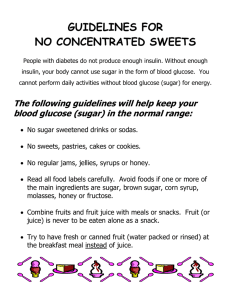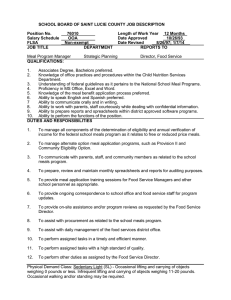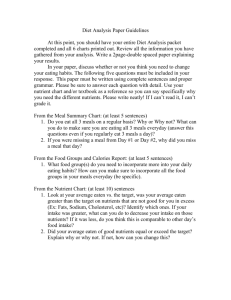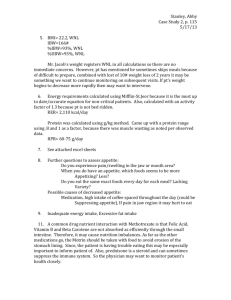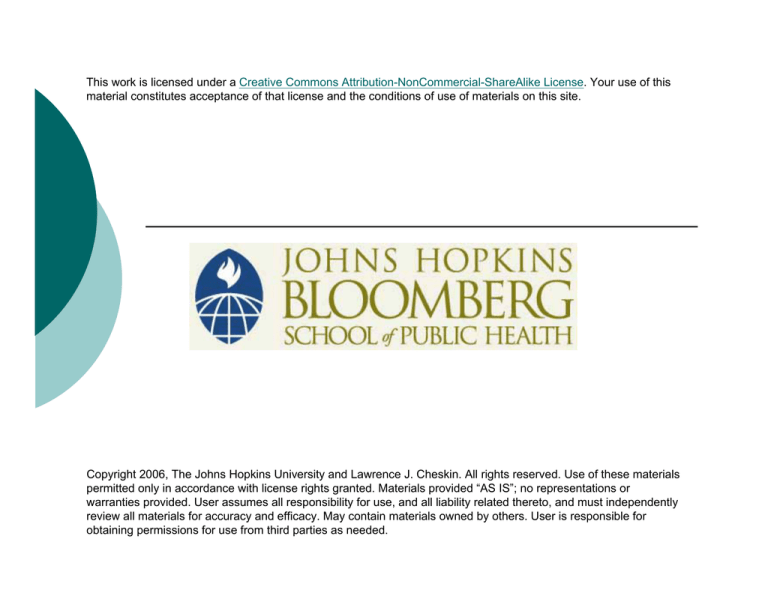
This work is licensed under a Creative Commons Attribution-NonCommercial-ShareAlike License. Your use of this
material constitutes acceptance of that license and the conditions of use of materials on this site.
Copyright 2006, The Johns Hopkins University and Lawrence J. Cheskin. All rights reserved. Use of these materials
permitted only in accordance with license rights granted. Materials provided “AS IS”; no representations or
warranties provided. User assumes all responsibility for use, and all liability related thereto, and must independently
review all materials for accuracy and efficacy. May contain materials owned by others. User is responsible for
obtaining permissions for use from third parties as needed.
Ingestive Science:
The Control of Eating
Critical Analysis of Popular Diets
and Supplements
Instructor: Lawrence J. Cheskin, M.D.
Associate Professor, International Health
Director, Johns Hopkins Weight Management Center
Measuring Food Intake
{
Problem: The act of measuring may
alter intake
z
z
{
{
“Demand characteristics”: the beliefs
about food(s), past experience, and desire
to be a “good subject” that influence
responses
Instructions to subjects matter: “Eat as
you normally do” vs. “eat to comfortable
fullness”
Choices: “Naturalness” vs. precision
Free-living observational vs. lab
studies
Power and Errors in Eating Studies
{
{
{
Statistical power is often low- small
n, large variability in consumption
Thus, type II errors are common
(missing a real effect)
Type I errors (finding an effect
when there is none) are less
common
Key features of the Appetite
Control System-I
{
{
{
{
Redundancy: overlapping control
mechanisms (defense of weight is highly
conserved genetically)
Bias towards overconsumption (genetic?)
Sensory cues are used to learn about
certain foods (what tastes good, what
causes harm)
Change in environment can change eating
z External: temperature of air or food
z Internal: being pregnant, being happy,
feeling ill
Key Features of the Appetite
Control System-II
{
{
Weight equilibrium (EI=EE) is the
norm for adults, but a new, higher wt
will also be maintained
Intake is influenced by physiologic (eg
drop in blood glucose predicts onset of
meal), learned (eg, that smells good,
let’s eat) and sometimes pathologic
factors (eg, eating disorders)
Components of Feeding Behavior:
{
{
{
{
Meal size
Meal frequency
Rate of meal ingestion
Composition of meal
Satiety (“Fullness”) SignalsTerminology
{
Satiation: intra-meal satiety; eg:
CCK- ends meals but does not increase
time between meals
{
Post-ingestive (PI) satiety:
maintenance of inhibition over further
intake (between meals)
{
Sensory-specific satiety (SSS):
decreased desire for a food just eaten,
but not general satiety;
eg, 10 licorice sticks = 150 kcal
Satiety (“Fullness”) SignalsMeasurement
{
How can we measure a subjective
sensation like hunger?
z
Visual analog scales (VAS): 100mm,
anchored at ends only (“extremely” and “not at
all” hungry)
z
z
Better than bipolar scale (hungry to full)
Better than categorical scale (not, somewhat,
moderately, very, most hungry ever)
Components of the
Appetite-Control System
{
{
{
{
{
{
Orosensory
Gastrointestinal
Liver
Circulating factors
Nutrient stores
Central and peripheral nervous system
Orosensory Component
{
{
{
{
Learned component is very
important
Smell is more specific than taste
Obese: generally similar in taste preferences to
lean, but find more palatable than lean the
mixture of sugar and fat
Primary tastes (in order of US preference):
{
{
{
{
{
Sweet
Salty
Unami (MSG)
Sour
Bitter
Gastrointestinal Component
{
Stomach:
z
z
z
z
z
Regulates the flow of energy into the small
intestine
Places a physical constraint on meal size
(gastric band)
Its size adapts to habitual meal size (starved
must eat small, freq meals initially to recover
their weight)
Stretch and CCK receptors in stomach
communicate with CNS to regulate speed of
ingestion and meal end
Small intestine stretch and
chemo/osmoreceptors feed back to stomach to
regulate gastric emptying rate
Liver Component
{
Liver receives, metabolizes,
distributes and stores all nutrients
(except chylomicrons, which are absorbed into
lymphatics: this may account for the
lesser/delayed satiety of fatty meals)
{
{
Liver may sense food:
rats- portal vein
infusion of glucose while feeding increases the
rat’s preference for that food
Poisoning liver metabolism:
feeding
stimulates
Circulating Factors Component
{
{
{
Evidence for circulating appetite
control factors: “sham fed” dogs
(distended stomach) are hyperphagic
However, direct feeding IV (TPN) is less
satiating than equal kcal orally
Circulating factors may include hormones,
neurochemicals, and circulating nutrients
themselves (eg, glucose)
Nutrient Stores Component
{
{
{
{
{
Distinct from circulating nutrients’ effect
Energy intake tends to increase after weight
loss
Parabiotic (shared circulation) rats: overfeed
one- the other eats less, loses weight
Leptin (satiety h.) levels are higher in obese
because leptin is stored in adipose tissues
Yet, little is known about how nutrient stores
affect eating behavior
Central and Peripheral Nervous
System Component-I
{
{
{
Very complex and not fully understood
Involves hormones/peptides; other
messengers like ATP, Ca; from gut,
tissues and brain
Learned component and imprinted
component interact (eg, cats who
learn to eat fruit)
Central and Peripheral Nervous
System Component-II
{
{
{
Brain areas that process peripheral
(vagal) and CNS feeding signals: area
postrema, nucleus of the solitary tract
AP/NST are linked to the forebrain’s
paraventricular nucleus, lateral and
ventromedial hypothalamus
LH and VMH contain glucosensitive
neurons
Central and Peripheral Nervous
System Component-III
In animal models:
{ Steroids, NE, NPY, GABA
CHO
intake
{ Opioids, aldosterone, galanin
fat intake
In obesity, find
sympathetic
activity, and thus blunted postprandial thermogenesis
Diet Composition and Satiety-I
Hierarchy of satiety per kcal:
protein, complex CHO, simple CHO, fat,
EtOH
EtOH may even stimulate further food
intake
Liquids are less satiating than solids
Diet Composition and Satiety-II
{
Micronutrients:
z
z
When made deficient in a
micronutrient, rats will select a diet
that corrects the deficiency
Humans may overeat in general to
correct micronutrient deficiencies
Post-Absorptive Influences on
Appetite
{
{
{
{
Blockade of glucose or fat metabolism
Æ increased EI in animals
High rates of glucose/fat oxidation Æ
decreased EI in animals
Humans: 6-12% drop in blood glucose
Æ meal initiation
Humans: high fat does not suppress
appetite
Obesity and Macronutrients
{
{
{
{
Obese prefer fattier foods more
than lean
“Passive” overconsumption of
calories may occur on high fat diets
Prevalence of obesity in populations
correlates with % dietary energy
from fat
Some evidence for geneticallyinfluenced ease of wt gain on high
fat diet (+FHx)

